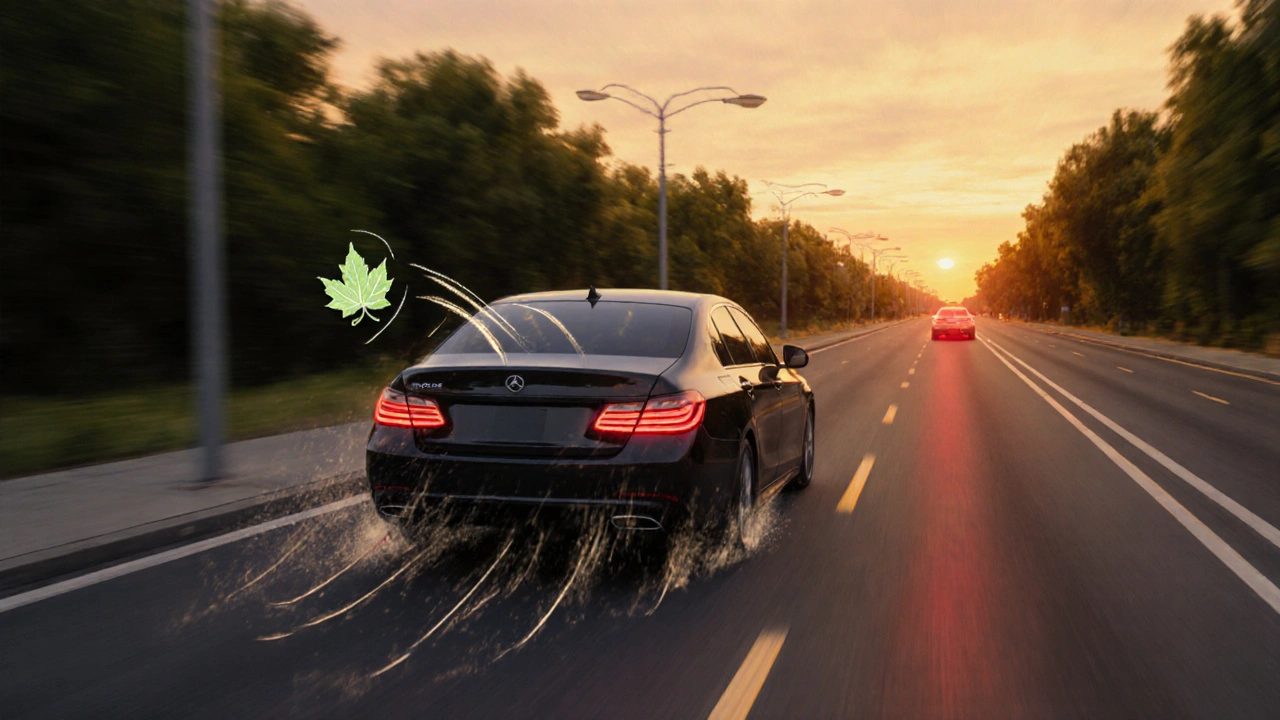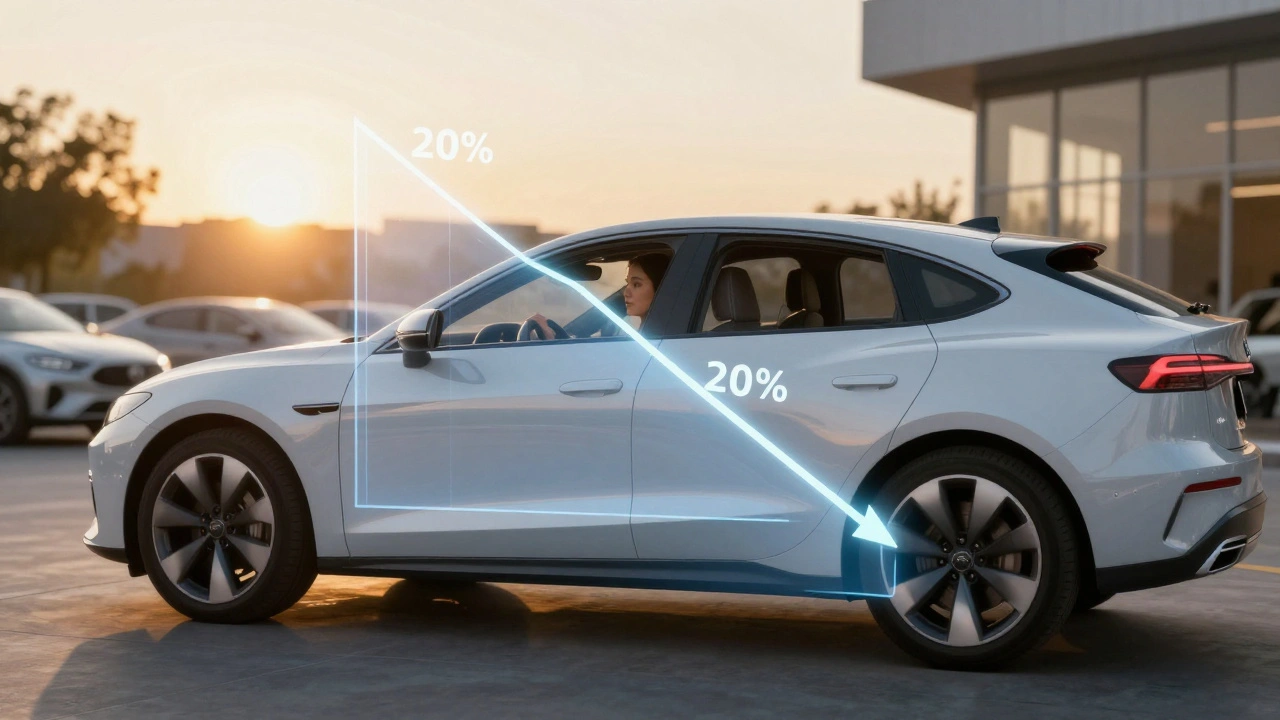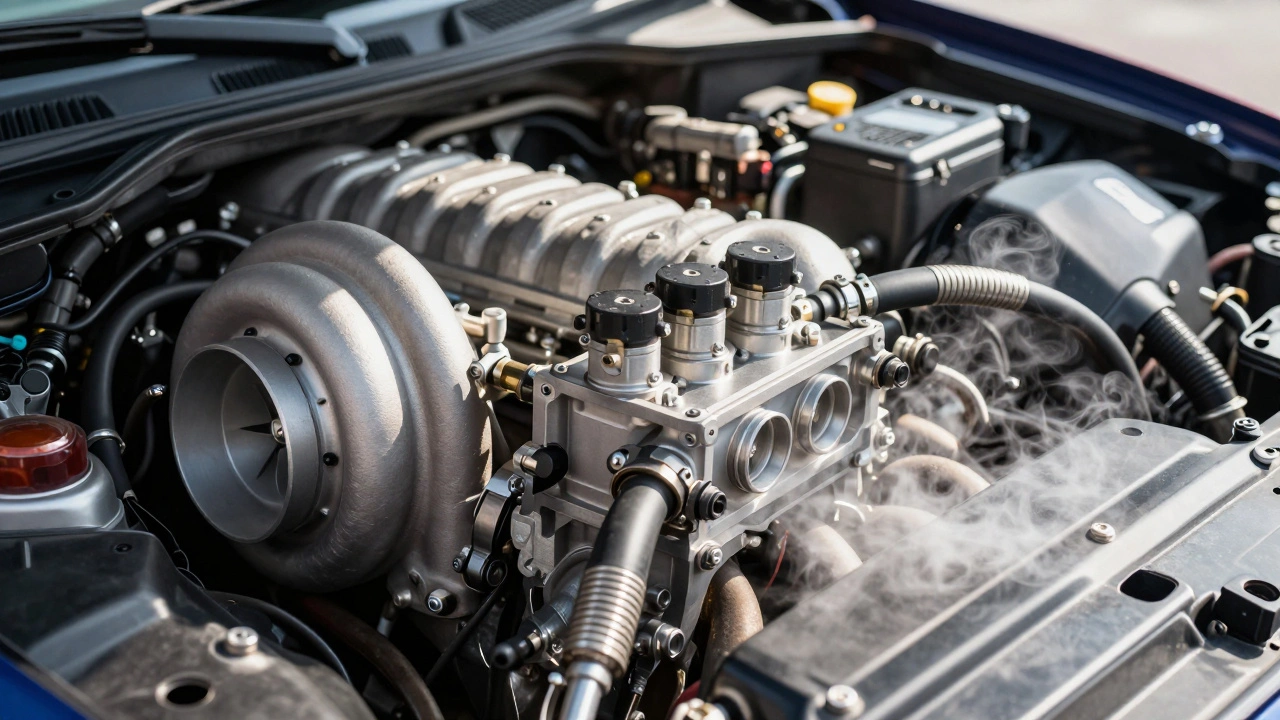Most drivers think fuel economy is about the car they drive. But the truth? How you drive matters just as much - maybe more. You can be in a 2025 Toyota Prius or a 2018 Honda Civic, and your fuel efficiency can swing by 30% or more based on simple habits behind the wheel. This isn’t theory. It’s data from the U.S. Department of Energy and real-world tests by AAA. The difference between aggressive driving and smooth, thoughtful driving can save you $500 a year on gas - and cut your carbon footprint in half.
Slow Down, Speed Up
> The biggest fuel killer isn’t idling. It’s rapid acceleration.Every time you punch the gas from a stop, you burn extra fuel. Studies show that accelerating too fast uses up to 40% more fuel than gradual acceleration. On city streets, this adds up fast. Instead of flooring it at green lights, ease into the pedal. Let the car build speed naturally. Most modern engines are tuned to be most efficient between 1,500 and 2,500 RPM. Keep your foot light, and your transmission will shift sooner, keeping you in that sweet spot.
And don’t speed. Driving at 75 mph instead of 65 mph can drop your fuel economy by 10-15%. That’s like paying an extra $0.50 per gallon. On a 500-mile road trip, that’s $25 extra. The EPA says the most efficient speed for most cars is between 50 and 60 mph. If you’re on the highway, cruise control isn’t just convenient - it’s a fuel saver. It maintains steady speed better than most humans can, especially on rolling terrain.
Anticipate, Don’t Brake
Braking wastes energy. Every time you slam on the brakes, you turn kinetic energy - the motion of your car - into heat. That heat is gone. You’ll have to burn more fuel to get back up to speed.
Look ahead. Watch traffic lights, brake lights, and merge points. If you see a red light 300 feet ahead, lift off the gas early. Let the car coast. Most modern vehicles have regenerative braking systems, but even those can’t recover all the energy you lose when you brake hard. Coasting reduces wear on your brakes, too. You’ll spend less on brake pads and rotors over time.
This technique is called “pulse and glide.” It works best on open roads with light traffic. Accelerate gently to your target speed, then ease off the pedal and let the car roll. Repeat. It’s not about going slow - it’s about avoiding unnecessary stops and starts.
Reduce Weight, Reduce Drag
Every extra 100 pounds in your car cuts your fuel economy by 1-2%. That means if you’re hauling around unused bike racks, golf clubs, or boxes in your trunk, you’re paying for it at the pump.
Remove roof racks when you’re not using them. Even an empty roof rack can increase drag by 5-10%, especially at highway speeds. A 2020 Consumer Reports test found that a roof box dropped fuel efficiency by 19% on a 75 mph drive. That’s not a small number. If you’re not carrying gear, take it off.
Keep your tires properly inflated. Underinflated tires increase rolling resistance. The DOE says driving on tires that are 10 psi below recommended pressure can reduce fuel economy by 3%. Check your tire pressure once a month, especially before long trips. Use the number on the driver’s side door jamb - not the one on the tire sidewall. That’s the maximum, not the recommendation.

Use Air Conditioning Wisely
Running the AC does use fuel - but not as much as you think. At low speeds, open windows create drag. At highway speeds, open windows hurt efficiency more than the AC. A 2004 study by the National Renewable Energy Laboratory found that at 65 mph, open windows reduced fuel economy by 2-8%, depending on the car. The AC only dropped it by 1-4%.
So here’s the rule: on city streets, crack the windows. On the highway, use the AC. And set it to a comfortable but not freezing temperature. Every degree lower than 72°F adds a small load. Use recirculation mode to cool the cabin faster, then switch to fresh air to avoid stale air buildup.
Maintain Your Car - It’s Part of Driving
Even the best eco-driving habits won’t help if your car is running poorly. A dirty air filter can reduce fuel economy by up to 10%. A faulty oxygen sensor? That can cut efficiency by 40%. These aren’t myths. The EPA says regular maintenance - oil changes, spark plug replacements, sensor checks - can improve mileage by 4-10%.
Use the manufacturer’s recommended grade of motor oil. Many newer cars require 0W-20 or 5W-30 synthetic oil. Using a heavier grade, like 10W-40, increases internal friction and lowers efficiency. Check your owner’s manual. Don’t guess.
Also, get your alignment checked yearly. Misaligned wheels cause uneven tire wear and drag. You won’t feel it until your tires are worn out - but you’ll feel it in your wallet every time you fill up.

Plan Your Trips
One long trip uses less fuel than three short ones. Cold engines burn more fuel. If you’re running three errands across town, do them all in one go. Let the engine warm up fully before you start driving hard. Idling for more than 60 seconds wastes fuel. Turn off the engine if you’re parked longer than that.
Use apps like GasBuddy or Google Maps to find the most efficient route. Sometimes the fastest route isn’t the most fuel-efficient. Avoid heavy traffic, stoplights, and steep hills if you can. In Asheville, for example, the route up the Blue Ridge Parkway might be scenic - but it’s a fuel hog. Stick to I-40 when you’re in a hurry.
Combine errands. Plan your week. Instead of driving to the grocery store, then the pharmacy, then the bank - do it all in one trip. You’ll save fuel, time, and stress.
Track Your Progress
You can’t improve what you don’t measure. Most modern cars have a fuel economy display. Use it. Watch how your MPG changes when you drive differently. Try a week of aggressive driving - then a week of eco-driving. You’ll see the difference.
Some apps like Fuelio or MileIQ let you log your fill-ups and track trends. You can even compare your driving style to others in your area. In Asheville, the average driver gets 24.3 MPG. With eco-driving, many hit 28-32 MPG - even in older cars.
Set a goal. Try to improve your average by 1 MPG each month. That’s not hard. It’s just about being more aware. Over a year, that’s 12% better fuel economy. For a car that gets 25 MPG, that’s 3 extra gallons per month - or $150 saved.
It’s Not About the Car - It’s About You
There’s no magic gadget or fuel additive that beats smart driving. The most efficient car on the road, driven poorly, will still guzzle gas. The most inefficient car, driven with care, can surprise you.
Eco-driving isn’t about being slow. It’s about being smooth. It’s about thinking ahead. It’s about treating your car like a tool, not a toy. When you drive this way, you save money. You reduce emissions. You make your car last longer. And you feel calmer behind the wheel.
Start tomorrow. Ease off the gas at the next light. Check your tire pressure. Take the roof rack off. You don’t need a new car to save fuel. You just need to change how you drive.
Does using cruise control really save gas?
Yes, especially on highways. Cruise control maintains a steady speed, which prevents small accelerations and decelerations that waste fuel. Human drivers tend to overcorrect, which increases fuel use. In hilly areas, some newer adaptive cruise systems adjust smoothly for elevation changes, making them even more efficient.
Is it better to idle or turn off the engine when stopped?
Turn off the engine if you’re stopped for more than 60 seconds - excluding traffic lights. Idling for a minute uses as much fuel as restarting the engine. Modern starters are built to handle frequent starts, and battery drain isn’t a concern in cars made after 2010. Don’t restart at red lights, but if you’re waiting for someone or parked for a few minutes, switch it off.
Do fuel additives really improve mileage?
Almost none do. The EPA tested over 100 fuel additives and found no consistent improvement in fuel economy. Some claim to clean injectors, but if your car is maintained properly, your fuel system is already clean. Save your money. The only proven way to improve mileage is through driving habits and maintenance.
Can I save fuel by driving in neutral downhill?
No, and it’s dangerous. Modern fuel-injected cars cut fuel delivery when coasting in gear. In neutral, the engine must idle to keep running, using fuel. You also lose engine braking, which increases wear on your brakes and reduces control. Always stay in gear when going downhill.
How much can eco-driving save me annually?
The average U.S. driver travels 13,500 miles per year. If your car gets 25 MPG and gas costs $3.50 per gallon, you spend about $1,890 a year on fuel. By adopting eco-driving techniques, you can improve efficiency by 10-20%. That’s $190 to $380 saved per year - enough to cover a full oil change, new tires, or a weekend trip.
Start small. Pick one technique - maybe checking tire pressure or easing off the accelerator - and stick with it for a week. Then add another. You don’t need to be perfect. You just need to be consistent. Over time, these small changes add up to big savings - at the pump, in your wallet, and for the planet.






Kayla Ellsworth
November 8, 2025 AT 05:05Wow. So if I just drive slower and check my tires, I’m suddenly a climate hero? What’s next, donating my toaster to save the planet?
Pooja Kalra
November 9, 2025 AT 20:33Driving smoothly is not about saving money. It’s about recognizing that acceleration is a form of violence against momentum. The road remembers every punch of the pedal.
Sumit SM
November 10, 2025 AT 02:02Let me be clear: cruise control doesn't save fuel-it just makes you lazy! And let’s not forget: the government, the oil companies, and the car manufacturers all want you to believe that YOU are the problem, not their design flaws! You’re being manipulated!
Jen Deschambeault
November 11, 2025 AT 15:44I started coasting to lights last week. My commute feels like meditation now. No more white-knuckling through traffic. Just calm. And my gas bill? Down 12%. Small wins matter.
Soham Dhruv
November 11, 2025 AT 21:56bro just check your tire pressure like once a month its not that hard and youll be shocked how much it helps
Jane San Miguel
November 12, 2025 AT 22:45It’s amusing how this article reduces complex systems of energy consumption to a series of performative behavioral adjustments. The real issue is systemic-infrastructure, urban design, and corporate obsolescence. But sure, let’s blame the driver.
Dave Sumner Smith
November 14, 2025 AT 02:37Yeah, and I’m sure the EPA is just a bunch of nice folks who care about your wallet. Meanwhile, your ‘eco-driving’ is just a distraction so they don’t have to regulate emissions from planes and factories.
Bob Buthune
November 15, 2025 AT 00:34I used to think this was all nonsense... until I lost my job, then my apartment, then my dog... and suddenly I was staring at a $500 gas bill and wondering if I was the reason the world was ending. Now I coast. I check my tires. I cry quietly in the driver’s seat. It’s the only control I have left.
Kasey Drymalla
November 15, 2025 AT 04:12they told us to use cruise control but its all a lie the government puts signals in the road to make your car waste fuel they want you to buy more gas
Paul Timms
November 16, 2025 AT 02:31Good breakdown. I’ve been doing pulse and glide on my 2012 Civic for a year now. Got 31 MPG consistently. No magic, just patience.
Nathaniel Petrovick
November 16, 2025 AT 15:14my mom does all this and she’s 72. she’s got better mpg than my new truck. she doesn’t even know what regenerative braking is. just slow and steady wins the race
Honey Jonson
November 16, 2025 AT 15:38i tried the roof rack thing and wow like 20 bucks saved on my last fill up. i feel like a genius lol
Cait Sporleder
November 18, 2025 AT 13:20The empirical data presented here is both robust and underappreciated. One must consider the thermodynamic inefficiencies inherent in kinetic energy dissipation through frictional braking, as well as the aerodynamic drag coefficients associated with external accessories. The psychological dimension-how habitual acceleration reinforces neural pathways of impatience-is equally compelling. This is not merely fuel economy; it is a philosophical recalibration of one’s relationship with motion.
Sally McElroy
November 20, 2025 AT 06:47You people are so naive. You think checking your tires makes you good? What about the fact that oil companies designed cars to be inefficient? You’re just playing their game. And don’t even get me started on how the government is using this to spy on your driving habits…
Jeroen Post
November 20, 2025 AT 23:42Everyone’s missing the point. The real fuel saver isn’t driving smooth. It’s not owning a car at all. But nobody wants to hear that because they’re addicted to the illusion of freedom. You’re all just consumers in a bigger lie.